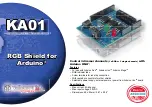
Address
Data
Last Data
First frame within block
Is
address
; it follows idle
period of 10 bits or more
Frame within
block
Idle period
less than 10
bits
Idle period
of
10 bits
or more
ÇÇÇ
ÇÇÇ
ÇÇÇ
ÇÇÇ
ÇÇÇ
ÇÇÇ
ÇÇÇ
ÇÇÇ
ÇÇÇ
ÇÇÇ
ÇÇÇ
ÇÇÇ
ÇÇ
ÇÇ
ÇÇ
ÇÇ
ÇÇ
ÇÇ
ÇÇ
ÇÇ
ÇÇ
ÇÇ
ÇÇ
ÇÇ
ÇÇ
ÇÇ
ÇÇ
ÇÇ
ÇÇ
ÇÇ
ÇÇ
ÇÇ
ÇÇ
ÇÇ
ÇÇ
ÇÇ
Several blocks of frames
Data format
(Pins SCIRXD, SCITXD)
Data format expanded
Idle periods of 10 bits or more
separate the blocks
Start
Start
Start
One block of frames
Enhanced SCI Module Overview
985
SPRUH22I – April 2012 – Revised November 2019
Copyright © 2012–2019, Texas Instruments Incorporated
C28 Serial Communications Interface (SCI)
because, unlike the idle mode, it does not have to wait between blocks of data. However, at a high
transmit speed, the program is not fast enough to avoid a 10-bit idle in the transmission stream.
13.1.1.4.2 Controlling the SCI TX and RX Features
The multiprocessor mode is software selectable via the ADDR/IDLE MODE bit (SCICCR, bit 3). Both
modes use the TXWAKE flag bit (SCICTL1, bit 3), RXWAKE flag bit (SCIRXST, bit1), and the SLEEP flag
bit (SCICTL1, bit 2) to control the SCI transmitter and receiver features of these modes.
13.1.1.4.3 Receipt Sequence
In both multiprocessor modes, the receive sequence is:
1. At the receipt of an address block, the SCI port wakes up and requests an interrupt (bit number 1
RX/BK INT ENA-of SCICTL2 must be enabled to request an interrupt). It reads the first frame of the
block, which contains the destination address.
2. A software routine is entered through the interrupt and checks the incoming address. This address
byte is checked against its device address byte stored in memory.
3. If the check shows that the block is addressed to the device CPU, the CPU clears the SLEEP bit and
reads the rest of the block; if not, the software routine exits with the SLEEP bit still set and does not
receive interrupts until the next block start.
13.1.1.5 Idle-Line Multiprocessor Mode
In the idle-line multiprocessor protocol (ADDR/IDLE MODE bit=0), blocks are separated by having a
longer idle time between the blocks than between frames in the blocks. An idle time of ten or more high-
level bits after a frame indicates the start of a new block. The time of a single bit is calculated directly from
the baud value (bits per second). The idle-line multiprocessor communication format is shown in
(ADDR/IDLE MODE bit is bit 3 of SCICCR).
Figure 13-4. Idle-Line Multiprocessor Communication Format
13.1.1.5.1 Idle-Line Mode Steps
The steps followed by the idle-line mode:
Step 1.
SCI wakes up after receipt of the block-start signal.
Step 2.
The processor recognizes the next SCI interrupt.
Step 3.
The interrupt service routine compares the received address (sent by a remote transmitter) to
its own.
Step 4.
If the CPU is being addressed, the service routine clears the SLEEP bit and receives the rest
of the data block.
Step 5.
If the CPU is not being addressed, the SLEEP bit remains set. This lets the CPU continue to
execute its main program without being interrupted by the SCI port until the next detection of
















































